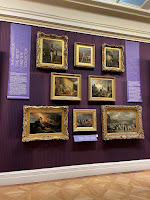Noémie Goudal: Post Atlantica

Beautiful exhibition at Adel Assanti of new work by Noémie Goudal. The work was a series of installations and videos which reflect the environment and climate issues. I finished a course on the sublime today and I think the works would fit with that definition. The main work, shown here, is a sculptural work which at first appears as a flat image, however you can walk around and through it and it changes as you do. Downstairs was a mesmeric video of a pool of water from which other photographic images of a similar environment rise and fell. Each image disrupted the reality you were seeing and you stayed to watch the effect of them coming and going. My favourite piece was a triptych video of waves hitting rocks which was layered and seemed to be a film over a statistic image. At times it stopped showing the image below which then made you try to look for the image beneath. It reminded me of one of my favourite places in the world, North Point in Barbados where you can stand and wa
















